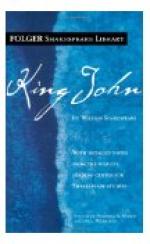|
This section contains 9,624 words (approx. 33 pages at 300 words per page) |

|
SOURCE: “Mingling Vice and ‘Worthiness’ in King John,” in Shakespeare Studies Annual, Vol. XXVII, 1999, pp. 109-33.
In the following essay, Weimann characterizes Faulconbridge as a new type of vice character, a type that merged the serious with the jocular.
With the advent of Marlowe the aims of representation in the Elizabethan theater were sharply redefined. As the prologues to Tamburlaine suggested, the dramatist literally felt authorized to “lead” the theater to a new horizon of legitimation, one against which the hero could more nearly be viewed as a self-contained “picture.” Such a portrait would “unfold” the scene “at large”; the character “himself in presence” would dominate the performance. This at least is how the Prologue to The Second Part of Tamburlaine the Great proceeded to elucidate the uses of “this tragic glass” in the earlier Prologue:
But what became of fair Zenocrate, And with how many cities' sacrifice...
|
This section contains 9,624 words (approx. 33 pages at 300 words per page) |

|


